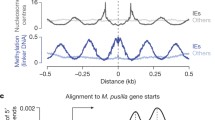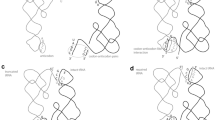Summary
A biogeochemical scenario is proposed, according to which prebiotic self-replication of RNA-like molecules evolved gradually from domain propagation to entire strand replication. The hypothetical replicating entities that formed an evolutionary continuity in time, the prebioectons, were characterized by self-structuring, and started their evolution from strands possessing one or more templatable domains. The inherent self-structuring implies a very early coevolution of the replicating molecules with prebiotic peptides, in line with the cassette model of Cedergren and Grosjean (1987). The proposed approach can be partially tested in the laboratory.
Similar content being viewed by others
References
Alberts B, Bray D, Lewis J, Raff M, Roberts K, Watson J (1983) Molecular biology of the cell. Garland, New York
Cech RT (1986) A model for the RNA-catalyzed replication of RNA. Proc. Natl Acad Sci USA 83:4360–4363
Cedergren R, Grosjean H (1987) On the primacy of primordial RNA. BioSystems 20:175–180
Darnell JE Jr (1983) The processing of RNA. Sci Am 249:72–82
Darnell JE, Doolittle WF (1986) Speculations on the early course of evolution. Proc Natl Acad Sci USA 83:1271–1275
de Bruijn M, Schreier P, Eperon I, Barrell B, Chen, E, Armstrong P, Wong J, Roe B (1980) A mammalian mitochondrial serine tRNA lacking the dihydrouridine loop and stem. Nucleic Acids Res 8:5213–5222
Dyson F (1985) Origins of life. Cambridge University Press, Cambridge
Eigen M, Schuster P (1979) The hypercycle. Springer-Verlag, Berlin
Eigen M, Winkler-Oswatitsch R (1981) Transfer-RNA, an early gene? Naturwissenschaften 68:282–292
Gibbs D, Lohrmann R, Orgel LE (1980) Template-directed synthesis and selective adsorption of oligoadenylates on hydroxyapatite. J Mol Evol 15:347–354
Gilbert W (1986) The RNA world. Nature 319:618
Guerrier-Takada C, Gardiner K, Marsh T, Pace N, Altman S (1983) The RNA world. Nature 319:618
Guerrier-Takada C, Gardiner K, Marsh T, Pace N, Altman S (1983) The RNA moiety of ribonuclease P is the catalytic subunit of the enzyme. Cell 35:849–857
Joyce GF (1987) Non-enzymatic template-directed synthesis of informational molecules. Cold Spring Harbor Symp Quant Biol LII:41–51
Kruger K, Grabrowski PJ, Zaug AJ, Sands J, Gottschling DE, Cech TR (1982) Self-splicing RNA: autoexcision and autocyclization of the ribosomal RNA intervening sequences ofTetrahymena. Cell 31:147–155
Kuhn H (1976) Model consideration for the origin of life. Naturwissenschaften 63:68–80
Lahav N (1985) The synthesis of primitive “being” forms: definition, goals, strategies and evolution synthesizers. Orgins Life 16:129–149
Lahav N, Chang S (1976) The possible role of solid surface area on condensation reactions during chemical evolution: reevaluation. J Mol Evol 8:357–380
Lahav N, White D (1980) The possible role of clay-water systems in the production of ordered oligomers and polymers. J Mol Evol 16:11–21
Orgel LE (1986) RNA catalysis and the origins of Life. J Theor Biol 123:127–149
Orgel LE (1987) Evolution of the genetic apparatus: a review. Cold Spring Harbor Symp Quant Biol LII:9–16
Pace R, Marsh TL (1985) RNA catalysis and the origins of Life. Origins Life 16:97–116
Ponnamperuma C, Hobish MK (1984) The sterochemical approach to studies of the origin of the genetic code. In: Matsuno K et al. (eds) Molecular evolution and protobiology. Plenum Press, New York
Reanney DC (1979) RNA splicing and polynucleotide evolution. Nature 277:598–606
Schwartz AW, Orgel LE (1985) Template-directed synthesis of novel, nucleic acid-like structures. Science 228:585–587
Uhlenbeck OC (1972) Complementary oligonucleotide binding to transfer RNA. J Mol Biol 65:25–41
Usher DA (1977) Early chemical evolution of nucleic acids: a theoretical model. Science 196:311–313
Von Kiedrowski G (1986) A self-replication hexadeoxynucleotide. Angew Chem Int Ed Engl 25:932
Wachtershauser G (1988) An all-purine precursor of nucleic acids. Proc Natl Acad Sci USA 85:1134–1135
Westheimer FH (1986) Polyribonucleic acids as enzymes. Nature 319:634–635
Zaug AJ, Cech TR (1986) The intervening RNA ofTetrahymena in an enzyme. Science 231:470–475
Zielinsky WS, Orgel LE (1987) Oligomerization of activated derivatives of 3′-amino-3′ deoxyguanosine or poly(C) and poly(dC) template. Nucleic Acids Res 13:2469–2472
Author information
Authors and Affiliations
Rights and permissions
About this article
Cite this article
Lahav, N. Exon-intron-like pattern of the first propagating molecule?. J Mol Evol 29, 475–479 (1989). https://doi.org/10.1007/BF02602918
Received:
Revised:
Issue Date:
DOI: https://doi.org/10.1007/BF02602918




